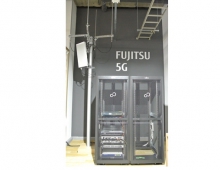
Fujitsu Develops Personal Authentication Technology to Integrate Palm Vein and Fingerprint Authentication
Fujitsu Laboratories today announced the development of the first biometric authentication technology that combines data on palm vein patterns with fingerprint data from three fingers.
By employing both palm vein pattern and fingerprint data, the technology enables the identification of a given individual out of data from a million people, processing the match within two seconds.
This technology makes it possible to construct biometric authentication systems that do not require ID cards and that can be tailor-made to fit different sized groups, from small-scale room access control to large-scale social platform systems. Moreover, the technology can be easily deployed by simply adding palm vein authentication to the fingerprint authentication systems that are already in widespread use.
To determine whether specific biometric data of a given individual recorded in an IC card is a match or not (one-to-one matching), such as is the case for authentication systems used in financial institutions, current authentication methods using just one type of biometric data are sufficient. However, when attempting to distinguish and identify a given person from a group of many people (one-to-many matching), precision becomes problematic if the pool of people is as large as a million or ten million people. This results in cases in which it is impossible to clearly distinguish among potential matches using just one type of biometric data.
One solution proposed for addressing this problem is to build a robust authentication system that combines multiple biometric authentication methods. Separately capturing the biometric data needed for each method, however, diminishes the convenience of this approach. For example, if palm vein authentication were combined with iris pattern authentication, both the palm and iris would each need to be separately scanned, compromising simplicity.
Fujitsu's system can identify a given person out of a pool of a million people, delivering one-to-one million matching. This was accomplished by combining fingerprint authentication, already in wide use and easily performed at high speed, with palm vein authentication, which has superior accuracy and is extraordinarily difficult to falsify, making it highly secure against fraud. The system developed with this technology uses palm vein and fingerprint data from three fingers. Capturing both finger and palm vein data in a single scan, the identity of a given person from a pool of a million can be authenticated within two seconds through parallel processing on multiple servers.
Fujitsu Laboratories plans to make it feasible to authenticate groups on the scale of 10 million people within fiscal 2011, and will also consider applications in a variety of scenarios.

This technology makes it possible to construct biometric authentication systems that do not require ID cards and that can be tailor-made to fit different sized groups, from small-scale room access control to large-scale social platform systems. Moreover, the technology can be easily deployed by simply adding palm vein authentication to the fingerprint authentication systems that are already in widespread use.
To determine whether specific biometric data of a given individual recorded in an IC card is a match or not (one-to-one matching), such as is the case for authentication systems used in financial institutions, current authentication methods using just one type of biometric data are sufficient. However, when attempting to distinguish and identify a given person from a group of many people (one-to-many matching), precision becomes problematic if the pool of people is as large as a million or ten million people. This results in cases in which it is impossible to clearly distinguish among potential matches using just one type of biometric data.
One solution proposed for addressing this problem is to build a robust authentication system that combines multiple biometric authentication methods. Separately capturing the biometric data needed for each method, however, diminishes the convenience of this approach. For example, if palm vein authentication were combined with iris pattern authentication, both the palm and iris would each need to be separately scanned, compromising simplicity.
Fujitsu's system can identify a given person out of a pool of a million people, delivering one-to-one million matching. This was accomplished by combining fingerprint authentication, already in wide use and easily performed at high speed, with palm vein authentication, which has superior accuracy and is extraordinarily difficult to falsify, making it highly secure against fraud. The system developed with this technology uses palm vein and fingerprint data from three fingers. Capturing both finger and palm vein data in a single scan, the identity of a given person from a pool of a million can be authenticated within two seconds through parallel processing on multiple servers.
Fujitsu Laboratories plans to make it feasible to authenticate groups on the scale of 10 million people within fiscal 2011, and will also consider applications in a variety of scenarios.





















